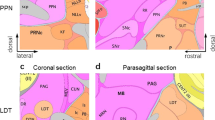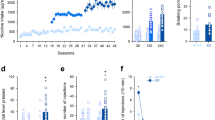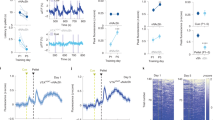Abstract
Smoking is the most important preventable cause of mortality and morbidity worldwide. This nicotine addiction is mediated through the nicotinic acetylcholine receptor (nAChR), expressed on most neurons, and also many other organs in the body. Even within the ventral tegmental area (VTA), the key brain area responsible for the reinforcing properties of all drugs of abuse, nicotine acts on several different cell types and afferents. Identifying the precise action of nicotine on this microcircuit, in vivo, is important to understand reinforcement, and finally to develop efficient smoking cessation treatments. We used a novel lentiviral system to re-express exclusively high-affinity nAChRs on either dopaminergic (DAergic) or γ-aminobutyric acid-releasing (GABAergic) neurons, or both, in the VTA. Using in vivo electrophysiology, we show that, contrary to widely accepted models, the activation of GABA neurons in the VTA plays a crucial role in the control of nicotine-elicited DAergic activity. Our results demonstrate that both positive and negative motivational values are transmitted through the dopamine (DA) neuron, but that the concerted activity of DA and GABA systems is necessary for the reinforcing actions of nicotine through burst firing of DA neurons. This work identifies the GABAergic interneuron as a potential target for smoking cessation drug development.
This is a preview of subscription content, access via your institution
Access options
Subscribe to this journal
Receive 12 print issues and online access
$259.00 per year
only $21.58 per issue
Buy this article
- Purchase on Springer Link
- Instant access to full article PDF
Prices may be subject to local taxes which are calculated during checkout





Similar content being viewed by others
References
WHO. World Health Organization Report on the Global Tobacco Epidemic, available from: http://www.who.int/tobacco/mpower/2009/en/, 2009.
Changeux JP . Nicotine addiction and nicotinic receptors: lessons from genetically modified mice. Nat Rev Neurosci 2010; 11: 389–401.
Taly A, Corringer PJ, Guedin D, Lestage P, Changeux JP . Nicotinic receptors: allosteric transitions and therapeutic targets in the nervous system. Nat Rev Drug Discov 2009; 8: 733–750.
Marti F, Arib O, Morel C, Dufresne V, Maskos U, Corringer PJ et al. Smoke extracts and nicotine, but not tobacco extracts, potentiate firing and burst activity of ventral tegmental area dopaminergic neurons in mice. Neuropsychopharmacology 2011; 36: 2244–2257.
Changeux JP, Edelstein SJ . Nicotinic Acetylcholine Receptors: From Molecular Biology to Cognition. Odile Jacob: New York, 2005.
Pontieri FE, Tanda G, Orzi F, Chiara GD . Effects of nicotine on the nucleus accumbens and similarity to those of addictive drugs. Nature 1996; 382: 255–257.
Picciotto MR, Zoli M, Rimondini R, Lena C, Marubio LM, Pich EM et al. Acetylcholine receptors containing the beta2 subunit are involved in the reinforcing properties of nicotine. Nature 1998; 391: 173–177.
Klink R, de Kerchove d’Exaerde A, Zoli M, Changeux JP . Molecular and physiological diversity of nicotinic acetylcholine receptors in the midbrain dopaminergic nuclei. J Neurosci 2001; 21: 1452–1463.
Mansvelder HD, McGehee DS . Cellular and synaptic mechanisms of nicotine addiction. J Neurobiol 2002; 53: 606–617.
Laviolette SR, van der Kooy D . The neurobiology of nicotine addiction: bridging the gap from molecules to behaviour. Nat Rev Neurosci 2004; 5: 55–65.
Mansvelder HD, Keath JR, McGehee DS . Synaptic mechanisms underlie nicotine-induced excitability of brain reward areas. Neuron 2002; 33: 905–919.
Mansvelder HD, McGehee DS . Long-term potentiation of excitatory inputs to brain reward areas by nicotine. Neuron 2000; 27: 349–357.
Luscher C, Malenka RC . Drug-evoked synaptic plasticity in addiction: from molecular changes to circuit remodeling. Neuron 2011; 69: 650–663.
Sulzer D . How addictive drugs disrupt presynaptic dopamine neurotransmission. Neuron 2011; 69: 628–649.
Mameli-Engvall M, Evrard A, Pons S, Maskos U, Svensson TH, Changeux JP et al. Hierarchical control of dopamine neuron-firing patterns by nicotinic receptors. Neuron 2006; 50: 911–921.
Dani JA, Bertrand D . Nicotinic acetylcholine receptors and nicotinic cholinergic mechanisms of the central nervous system. Annu Rev Pharmacol Toxicol 2007; 47: 699–729.
Olivo-Marin JC . Extraction of spots in biological images using multiscale products. Pattern Recogn 2002; 35: 1989–1996.
Tolu S, Avale ME, Nakatani H, Pons S, Parnaudeau S, Tronche F et al. A versatile system for the neuronal subtype specific expression of lentiviral vectors. FASEB J 2010; 24: 723–730.
Maskos U, Molles BE, Pons S, Besson M, Guiard BP, Guilloux JP et al. Nicotine reinforcement and cognition restored by targeted expression of nicotinic receptors. Nature 2005; 436: 103–107.
David V, Cazala P . A comparative study of self-administration of morphine into the amygdala and the ventral tegmental area in mice. Behav Brain Res 1994; 65: 205–211.
David V, Durkin TP, Cazala P . Differential effects of the dopamine D2/D3 receptor antagonist sulpiride on self-administration of morphine into the ventral tegmental area or the nucleus accumbens. Psychopharmacology (Berl) 2002; 160: 307–317.
David V, Segu L, Buhot MC, Ichaye M, Cazala P . Rewarding effects elicited by cocaine microinjections into the ventral tegmental area of C57BL/6 mice: involvement of dopamine D1 and serotonin1B receptors. Psychopharmacology (Berl) 2004; 174: 367–375.
David V, Gold LH, Koob GF, Cazala P . Anxiogenic-like effects limit rewarding effects of cocaine in balb/cbyj mice. Neuropsychopharmacology 2001; 24: 300–318.
David V, Besson M, Changeux JP, Granon S, Cazala P . Reinforcing effects of nicotine microinjections into the ventral tegmental area of mice: dependence on cholinergic nicotinic and dopaminergic D1 receptors. Neuropharmacology 2006; 50: 1030–1040.
Mason PA, Milner PM, Miousse R . Preference paradigm: provides better self-stimulation reward discrimination than a rate-dependent paradigm. Behav Neural Biol 1985; 44: 521–529.
David V, Matifas A, Gavello-Baudy S, Decorte L, Kieffer BL, Cazala P . Brain regional Fos expression elicited by the activation of mu- but not delta-opioid receptors of the ventral tegmental area: evidence for an implication of the ventral thalamus in opiate reward. Neuropsychopharmacology 2008; 33: 1746–1759.
Maskos U . Emerging concepts: novel integration of in vivo approaches to localise the function of nicotinic receptors. J Neurochem 2007; 100: 596–602.
Wise R . Brain reward circuitry: insights from unsensed incentives. Neuron 2002; 36: 229–240.
Maskos U . The cholinergic mesopontine tegmentum is a relatively neglected nicotinic master modulator of the dopaminergic system: relevance to drugs of abuse and pathology. Br J Pharmacol 2008; 153 (Suppl 1): S438–S445.
Maskos U . Role of endogenous acetylcholine in the control of the dopaminergic system via nicotinic receptors. J Neurochem 2010; 114: 641–646.
Petersen DR, Norris KJ, Thompson JA . A comparative study of the disposition of nicotine and its metabolites in three inbred strains of mice. Drug Metab Dispos 1984; 12: 725–731.
Graupner M, Gutkin BS . Modeling nicotinic neuromodulation from global functional and network levels to nAChR based mechanisms. Acta Pharmacol Sin 2009; 30: 681–693.
Graupner M, Gutkin BS In: Gutkin BS, Ahmed SH (eds). Computational Neuroscience of Drug Addiction, Computational Neuroscience Series. Springer Verlag: Berlin, 2011, pp 111–144.
Dobi A, Margolis EB, Wang H-L, Harvey BK, Morales M . Glutamatergic and nonglutamatergic neurons of the ventral tegmental area establish local synaptic contacts with dopaminergic and nondopaminergic neurons. J Neurosci 2010; 30: 218–229.
Graupner M, Gutkin BS . Tonic acetylcholine governs the phasic mesolimbic dopamine response to nicotine. PLoS Comp Biol 2012 (under consideration).
Turiault M, Parnaudeau S, Milet A, Parlato R, Rouzeau JD, Lazar M et al. Analysis of dopamine transporter gene expression pattern—generation of DAT-iCre transgenic mice. FEBS J 2007; 274: 3568–3577.
Fuchs EC, Doheny H, Faulkner H, Caputi A, Traub RD, Bibbig A et al. Genetically altered AMPA-type glutamate receptor kinetics in interneurons disrupt long-range synchrony of gamma oscillation. Proc Natl Acad Sci USA 2001; 98: 3571–3576.
Fields HL, Hjelmstad GO, Margolis EB, Nicola SM . Ventral tegmental area neurons in learned appetitive behavior and positive reinforcement. Annu Rev Neurosci 2007; 30: 289–316.
Bromberg-Martin ES, Matsumoto M, Hikosaka O . Dopamine in motivational control: rewarding, aversive, and alerting. Neuron 2010; 68: 815–834.
Valjent E, Pages C, Herve D, Girault JA, Caboche J . Addictive and non-addictive drugs induce distinct and specific patterns of ERK activation in mouse brain. Eur J Neurosci 2004; 19: 1826–1836.
Girault JA, Valjent E, Caboche J, Herve D . ERK2: a logical AND gate critical for drug-induced plasticity? Curr Opin Pharmacol 2007; 7: 77–85.
Grace AA . Phasic versus tonic dopamine release and the modulation of dopamine system responsivity: a hypothesis for the etiology of schizophrenia. Neuroscience 1991; 41: 1–24.
Schultz W . Multiple dopamine functions at different time courses. Annu Rev Neurosci 2007; 30: 259–288.
Gonon FG . Nonlinear relationship between impulse flow and dopamine released by rat midbrain dopaminergic neurons as studied by in vivo electrochemistry. Neuroscience 1988; 24: 19–28.
Chergui K, Svenningsson P, Nomikos GG, Gonon F, Fredholm BB, Svennson TH . Increased expression of NGFI-A mRNA in the rat striatum following burst stimulation of the medial forebrain bundle. Eur J Neurosci 1997; 9: 2370–2382.
Tsai HC, Zhang F, Adamantidis A, Stuber GD, Bonci A, de Lecea L et al. Phasic firing in dopaminergic neurons is sufficient for behavioral conditioning. Science 2009; 324: 1080–1084.
Corrigall WA . Nicotine self-administration in animals as a dependence model. Nicotine Tob Res 1999; 1: 11–20.
Rose JE, Corrigall WA . Nicotine self-administration in animals and humans: similarities and differences. Psychopharmacology (Berl) 1997; 130: 28–40.
Wessler I, Kirkpatrick CJ . Acetylcholine beyond neurons: the non-neuronal cholinergic system in humans. Br J Pharmacol 2008; 154: 1558–1571.
Nair-Roberts RG, Chatelain-Badie SD, Benson E, White-Cooper H, Bolam JP, Ungless MA . Stereological estimates of dopaminergic, GABAergic and glutamatergic neurons in the ventral tegmental area, substantia nigra and retrorubral field in the rat. Neuroscience 2008; 152: 1024–1031.
Nashmi R, Xiao C, Deshpande P, McKinney S, Grady SR, Whiteaker P et al. Chronic nicotine cell specifically upregulates functional alpha 4* nicotinic receptors: basis for both tolerance in midbrain and enhanced long-term potentiation in perforant path. J Neurosci 2007; 27: 8202–8218.
Schultz W . Getting formal with dopamine and reward. Neuron 2002; 36: 241–263.
Zweifel LS, Parker JG, Lobb CJ, Rainwater A, Wall VZ, Fadok JP et al. Disruption of NMDAR-dependent burst firing by dopamine neurons provides selective assessment of phasic dopamine-dependent behavior. Proc Natl Acad Sci USA 2009; 106: 7281–7288.
Overton PG, Clark D . Burst firing in midbrain dopaminergic neurons. Brain Res 1997; 25: 312–334.
Tepper JM, Lee CR In: Tepper JM, Abercrombie ED, Bolam JP (eds). Progress in Brain Research Vol. 160. Elsevier: Amsterdam, pp 189–208##2007.
Deister CA, Teagarden MA, Wilson CJ, Paladini CA . An intrinsic neuronal oscillator underlies dopaminergic neuron bursting. J Neurosci 2009; 29: 15888–15897.
Canavier CC, Landry RS . An increase in AMPA and a decrease in SK conductance increase burst firing by different mechanisms in a model of a dopamine neuron in vivo. J Neurophysiol 2006; 96: 2549–2563.
Kitai ST, Shepard PD, Callaway JC, Scroggs R . Afferent modulation of dopamine neuron firing patterns. Curr Opin Neurobiol 1999; 9: 690–697.
Exley R, Maubourguet N, David V, Eddine R, Evrard A, Pons S et al. Distinct contributions of nicotinic acetylcholine receptor subunit {alpha}4 and subunit {alpha}6 to the reinforcing effects of nicotine. Proc Natl Acad Sci USA 2011; 108: 7577–7582.
Floresco SB, West AR, Ash B, Moore H, Grace AA . Afferent modulation of dopamine neuron firing differentially regulates tonic and phasic dopamine transmission. Nat Neurosci 2003; 6: 968–973.
Grace AA, Floresco SB, Goto Y, Lodge DJ . Regulation of firing of dopaminergic neurons and control of goal-directed behaviors. Trends Neurosci 2007; 30: 220–227.
Lodge DJ, Grace AA . The laterodorsal tegmentum is essential for burst firing of ventral tegmental area dopamine neurons. Proc Natl Acad Sci USA 2006; 103: 5167–5172.
Omelchenko N, Sesack SR . Ultrastructural analysis of local collaterals of rat ventral tegmental area neurons: GABA phenotype and synapses onto dopamine and GABA cells. Synapse 2009; 63: 895–906.
Hong S, Hikosaka O . The globus pallidus sends reward-related signals to the lateral habenula. Neuron 2008; 60: 720–729.
Lobb CJ, Wilson CJ, Paladini CA . A dynamic role for GABA receptors on the firing pattern of midbrain dopaminergic neurons. J Neurophysiol 2010; 104: 403–413.
Grace AA, Bunney BS . Opposing effects of striatonigral feedback pathways on midbrain dopamine cell activity. Brain Res 1985; 333: 271–284.
Oster MA, Faure P, Gutkin BS . Society for Neuroscience Annual Meeting. San Diego, CA, 2010.
Graupner M, Gutkin BS . Society for Neuroscience Annual Meeting. Chicago, IL, 2009.
Miwa JM, Freedman R, Lester HA . Neural systems governed by nicotinic acetylcholine receptors: emerging hypotheses. Neuron 2011; 70: 20–33.
Dalley JW, Everitt BJ, Robbins TW . Impulsivity, compulsivity, and top–down cognitive control. Neuron 2011; 69: 680–694.
Acknowledgements
We thank Benoît Forget and Henri Korn for helpful comments on the manuscript, and Jochen Roeper for help with slice electrophysiology. This work was supported by the Institut Pasteur, Centre National de la Recherche Scientifique CNRS URA 2182, UMR 7102, UMR 5287 and ATIP programme, the Agence Nationale pour la Recherche (ANR Neuroscience, Neurologie et Psychiatrie 2005 and 2009, and ANR BLANC 2009), Neuropôle IdF, INSERM U960, the RTRA Ecole des Neurosciences de Paris and the Bettencourt Schueller Foundation. The research leading to these results has received funding from the European Union Seventh Framework Programme under Grant no. HEALTH-F2-2008-202088 (‘NeuroCypres’ project to U.M.). ST acknowledges financial support from Fondation de la Recherche Médicale (FRM), and Pasteur-Weizmann.
Author information
Authors and Affiliations
Corresponding authors
Ethics declarations
Competing interests
The authors declare no conflict of interest.
Additional information
Supplementary Information accompanies the paper on the Molecular Psychiatry website
Rights and permissions
About this article
Cite this article
Tolu, S., Eddine, R., Marti, F. et al. Co-activation of VTA DA and GABA neurons mediates nicotine reinforcement. Mol Psychiatry 18, 382–393 (2013). https://doi.org/10.1038/mp.2012.83
Received:
Revised:
Accepted:
Published:
Issue Date:
DOI: https://doi.org/10.1038/mp.2012.83
Keywords
This article is cited by
-
Impact of the gut microbiome on nicotine’s motivational effects and glial cells in the ventral tegmental area in male mice
Neuropsychopharmacology (2023)
-
Net gain and loss: influence of natural rewards and drugs of abuse on perineuronal nets
Neuropsychopharmacology (2023)
-
Midbrain projection to the basolateral amygdala encodes anxiety-like but not depression-like behaviors
Nature Communications (2022)
-
Dopamine, behavior, and addiction
Journal of Biomedical Science (2021)
-
Response dynamics of midbrain dopamine neurons and serotonin neurons to heroin, nicotine, cocaine, and MDMA
Cell Discovery (2018)



